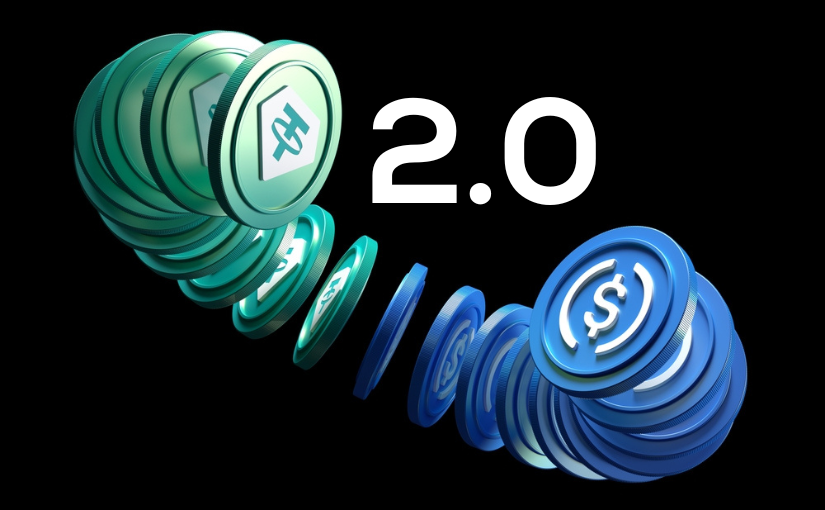Stablecoins 2.0: yield, settlement, better UX

What if your dollars quietly earned a return, settled payments in seconds, and felt as easy as your favorite app?
That’s the promise of “Stablecoins 2.0” — and it’s not hype. It’s already peeking through in the tools I test and track every day on Cryptolinks News. Stablecoins are shifting from basic “hold and send” balances to productive, programmable money that actually works for normal people and busy teams.
“Digital dollars should earn, settle instantly, and be effortless to use. That’s the bar now.”
Where things still hurt today

I see the same pain points again and again — from freelancers and merchants to DeFi power users:
- Idle cash: Most stablecoins sit dead. Meanwhile, U.S. T-bill rates have hovered around 4–5%, but users rarely see that yield passed through.
- Slow or pricey fiat rails: Bank wires, SWIFT, and card networks add delays and fees. The World Bank still tracks global remittance costs near 6% on average. That stings if you’re sending cross-border often.
- Clunky wallets and gas: New users wrestle with seed phrases, “what chain?” questions, and gas tokens just to send a $20 payment. Not exactly friendly.
- Business reconciliation: Matching invoices to on-chain payments across chains and tokens is still too manual. Finance teams want clearer memos, better tooling, and audit-ready logs.
- Compliance anxiety: Teams ask: Are we screening counterparties correctly? What if an asset blacklists addresses? How do we document this for auditors?
- Depegs and trust: Big names help, but users remember shocks. They want reserve clarity, strong on-chain liquidity, and predictable redemptions.
And yet, the rails are getting undeniably better. Stablecoins already move at internet speed: Visa’s public Stablecoin Dashboard has tracked trillions in on-chain transfer volume, and companies like Stripe now support USDC payouts on networks with low fees and fast finality. On the UX side, Ethereum’s ERC-4337 and account abstraction tools are making gasless sends and safer wallets real, not theoretical.
The promise taking shape
“Stablecoins 2.0” is the upgrade path I’m watching most closely:
- Native yield: Designs that pass through T‑bill or on-chain returns so your stable balance isn’t just asleep.
- Instant settlement: Pay any wallet, any time, with finality in seconds and fees measured in cents (often less) on modern L2s and high-throughput chains. Check live costs on L2Fees.info.
- Better UX: Gasless payments, simple recovery, and human-readable handles — the stuff that makes payments feel normal instead of “crypto-hard.” See the direction on account abstraction.
- Risk, transparency, and compliance: Clear reserve reporting, predictable redemption, and enterprise-ready controls for KYC/AML and approvals.
Real-world signals keep stacking up:
- USDC/USDT ubiquity: Deep liquidity across major exchanges and DeFi protocols, plus growing support in mainstream payment flows.
- Rising yield pass-through: Products like USDM (Mountain), USDY (Ondo), and wrappers like sDAI point to a future where “holding dollars” doesn’t mean giving up yield. Designs vary widely — and risks do, too — but the direction is clear.
- Programmable finance: Stablecoin invoices with embedded metadata, automated split payouts, and pay-in-stablecoin/settle-in-fiat “hybrid” flows are starting to feel like standard SaaS features, not science projects.
Who this is for — and what you’ll get next
If any of these sound familiar, you’re in the right place:
- Savers and treasurers: Want yield without turning the risk dial to 11.
- Freelancers and merchants: Want to send invoices, get paid fast, and off-ramp cleanly.
- Teams and CFOs: Want 24/7 settlement, tighter control, and audit-friendly records.
- Traders and DeFi users: Want liquidity, speed, and fees they can actually control.
As we go, I’ll answer the questions I get most:
- Where does stablecoin yield actually come from, and what’s sustainable?
- How do instant, global settlements work in practice?
- Which UX upgrades matter (gasless, recovery, handles), and where can you use them today?
- What risks really matter — depeg, custody, smart contracts, regulatory — and how do you manage them?
- What are the practical setups that let you start small, stay safe, and scale confidently?
Curious where this shift started and what “yield-bearing stablecoin” actually means in plain English? That’s exactly what I’m breaking down next — with simple examples and the trade-offs that actually matter. Ready?
Stablecoins 2.0 explained: from static dollars to productive, programmable money

Old-school stablecoins were simple: hold, send, repeat. Useful, but your dollars just sat there. Today’s version is different. I can hold a dollar token that quietly earns yield, move it across chains in seconds, and plug it into apps that feel as smooth as a regular fintech wallet.
Think of it like this: the first era turned dollars into internet files. The new era turns them into productive, programmable dollars—money that works while it moves.
“Money should move at the speed of the internet.” — David Marcus
That speed and productivity are already visible. Chainalysis has noted that stablecoins now make up the majority of on-chain transaction volume, and Visa has settled merchant payments using USDC on public blockchains. The rails are real—and they’re getting better.
What is a yield-bearing stablecoin?
A yield-bearing stablecoin is a dollar-pegged token that passes portfolio returns (usually from short-term Treasuries or on-chain strategies) to holders—Automatically. No extra clicks, no manual staking needed. It’s still designed to track $1, but it streams or accrues yield in the background.
Two common ways it works:
- Rebasing balance: Your token count increases over time while the price stays ~$1.
- Rising redemption value: Your token balance stays the same, but each token can be redeemed for slightly more over time.
Real examples you can research and use (where eligible):
- sDAI — DAI deposited into Maker’s DSR (Dai Savings Rate). You hold sDAI and earn from Maker’s reserve portfolio, which includes short-term U.S. Treasuries via RWA vaults.
- USDM — Mountain Protocol’s USDM auto-rebases yield from short-dated U.S. Treasuries to holders. Not available to U.S. persons; KYC applies.
- USDY — Ondo’s USDY accrues yield by increasing redemption value based on a portfolio of Treasuries and bank deposits. KYC/region restrictions apply.
- sFRAX — Frax’s sFRAX aims to pass through conservative yield to holders with a $1 target.
How these differ from standard non-yield tokens like USDC, USDT, USDP, or PYUSD: those aim to hold $1 and be widely spendable, but they don’t pay you the underlying reserve yield. In Stablecoins 2.0, you can hold a yield-bearing token for idle cash and swap to a non-yield token at payment time if needed.
Stablecoin types: fiat-backed, crypto-collateralized, hybrid, and synthetic
What backs a stablecoin shapes how stable it is, how transparent it can be, who can censor it, and whether it can pay yield. Here’s the quick map:
- Fiat-backed (off-chain reserves like cash, T-bills, bank deposits)
Examples: USDC, USDT, USDP, PYUSD, yield-bearing variants like USDM and USDY.
Pros: Tight $1 peg, deep liquidity, simple mental model.
Cons: Censorship/blacklist risk, reliance on banks/custodians. Most do not share reserve yield with holders (exceptions noted).
Yield: Possible if issuer chooses to pass through T-bill returns (e.g., USDM, USDY). - Crypto-collateralized (on-chain collateral like ETH, stETH; often overcollateralized)
Examples: DAI (now partially backed by RWAs), LUSD (ETH-only, no RWA exposure).
Pros: Transparent on-chain reserves, stronger censorship resistance (protocol-level).
Cons: Exposure to crypto volatility; peg depends on incentives and liquidation systems.
Yield: Often available via wrappers like sDAI. - Hybrid (mix of crypto collateral and off-chain assets or algorithmic mechanisms)
Examples: FRAX, GHO (Aave-native, with unique incentives).
Pros: Flexibility, multiple liquidity levers.
Cons: More moving parts; you must understand how it holds the peg across regimes.
Yield: Possible via ecosystem-specific wrappers (e.g., sFRAX). - Synthetic/derivative-backed (hedged positions like perp futures + staking to maintain a $1 target)
Examples: USDe (Ethena), historical designs like UXD.
Pros: Capital-efficient, can offer attractive yields in certain market conditions.
Cons: Basis/funding-rate risk, exchange/venue risks, more complex to reason about.
Yield: Often from funding rates and staking—very regime dependent.
Short version: fiat-backed tends to be the most “plug-and-play” for payments, crypto-collateralized brings on-chain transparency and censorship resistance, hybrids try to balance both, and synthetics lean on market hedging. Yield can exist in any bucket, but the source of that yield—and its sustainability—varies a lot.
How does this shift impact everyday users and businesses?
Stablecoins 2.0 cut dead time, reduce fees, and make idle balances work. Here’s what that looks like in real life:
- Freelancers and remote teams: Get paid in minutes instead of days, even across borders. Hold in a yield-bearing token like sDAI or USDM between invoices, then swap to USDC/PYUSD to pay bills. Lower fees, fewer bank surprises.
- Merchants: Accept stablecoin payments 24/7 and move funds instantly to a treasury wallet. Keep operating cash in a spendable stablecoin and park surplus in a yield-bearing wrapper with fast exit. No cutoff times, better cash efficiency.
- B2B and suppliers: Quote in a stablecoin both sides can handle (USDC and USDT are often safest for counterparties). Settle on a low-fee chain and reference invoice IDs in on-chain memos for clean reconciliation. If you need fiat, off-ramp locally the same day via trusted providers.
- Treasurers: Split balances by purpose: working capital in a broadly accepted stablecoin; reserves in compliant, transparent yield-bearing instruments with clear redemption paths. Real-time liquidity, fewer wire fees, audit-friendly trails.
One note from the trenches: yield-bearing tokens aren’t always the best payment currency yet. Liquidity and checkout support can lag. Many teams hold yield-bearing in treasury and convert to a major non-yield token right before spending—takes seconds, costs pennies on the right chain.
Under the hood, cross-chain rails are maturing too. USDC’s CCTP burns-and-mints rather than “bridging IOUs,” which helps preserve the $1 guarantee across chains. That means moving funds to the cheapest, fastest venue for each transaction is becoming a standard operating move, not a headache.
I care about the human side most. Money that sits still while prices rise feels like running on a treadmill. With Stablecoins 2.0, I can finally tell idle dollars to work—without giving up the ability to pay anyone, anywhere, almost instantly.
But here’s the obvious question: if these tokens can pay you, where does that yield actually come from—and how can you tell what’s solid versus just subsidized hype? Let’s sort that out next.
Yield 101: where stablecoin returns actually come from

I like my dollars to work while I sleep, but I also want to know exactly what they’re doing. Here’s the plain-English map of where stablecoin yield really comes from—and what can make it move.
Main sources of yield
- Short-term U.S. Treasuries via reserves — When stablecoins (or their wrappers) hold T‑bills, holders can get that interest passed through.
- Examples: USDM (Mountain Protocol) rebases to pass T‑bill yield to holders; sDAI (DAI Savings Rate) wraps DAI and accrues yield from Maker’s RWA/T‑bill allocation; USDY (Ondo) represents a tokenized note that accrues yield via redemption value (tradable near $1, but designed for investment, not point-of-sale).
- What moves APY: front-end rates from the Fed and how much of the reserve yield is actually shared with you vs. kept by the issuer.
- On-chain money markets — Supplying stablecoins to lending protocols earns variable interest from borrowers.
- Examples: Aave, Compound.
- What moves APY: utilization (how many people are borrowing), risk parameters, and chain-specific demand.
- Liquidity provision (LP) — Providing stable-stable liquidity earns trading fees and sometimes incentives.
- Examples: USDC/USDT pools on Curve or Uniswap. Impermanent loss is modest in tight stable pairs but not zero during volatility or depegs.
- What moves APY: trade volume, pool balance, and any token incentives.
- Real-world asset (RWA) credit — Lending against off-chain borrowers with on-chain rails.
- Examples: Maple, TrueFi, Centrifuge. Higher potential yield, but it’s underwriting credit risk.
- What moves APY: borrower quality, underwriting, recovery processes, and macro credit spreads.
One important nuance: most big fiat-backed stablecoins (USDC, USDT, PYUSD) keep reserve yield at the issuer level. You earn only if you opt into a wrapper that passes it through (e.g., sDAI, USDM) or you deploy the stablecoin into a yield venue.
“Only when the tide goes out do you discover who’s been swimming naked.” — Warren Buffett
Is stablecoin yield “safe” and what risks should I care about?
Yield is never free. Here’s the risk map I actually use before I click “deposit.”
- Depeg risk: Token trades away from $1 due to confidence shock or mechanism failure.
- Real-world: USDC briefly depegged in March 2023 after SVB exposure was revealed; UST collapsed in 2022.
- Mitigate: favor assets with robust reserves, clear attestations, deep on/off-chain liquidity, and sane mint/redeem mechanics.
- Reserve/custody risk: Are the assets really there, segregated, and quickly redeemable?
- Smart contract risk: Bugs, oracle failures, or governance exploits can nuke your deposit.
- Mitigate: audited, battle-tested protocols; time-tested oracles; conservative LTVs.
- Market/liquidity risk: Thin liquidity on your chain or pool means slippage or stuck exits during stress.
- Regulatory/censorship risk: Issuers can freeze addresses; rules can change mid-game.
- Real-world: USDC and USDT have frozen sanctioned addresses before; check blacklist policies.
- Platform security risk: Centralized platforms can halt withdrawals or fail operationally.
- Real-world: multiple 2022 blow-ups showed why “not your keys” still matters.
- Concentration risk: Too much exposure to one issuer, one protocol, one bank, or one chain/bridge.
How do I earn yield without taking on degen risk?
Think in layers. Start with the boring base that lets you sleep, then step out only if you truly understand the trade.
- Lower-risk starting points
- Reserve passthrough stablecoins: USDM (rebasing T‑bill exposure), sDAI (DSR). Transparency and redemption mechanics are the key checks.
- Top-tier money markets: Supplying USDC/USDT/DAI on Aave/Compound with conservative caps. Watch utilization and borrow demand.
- Tokenized T‑bill funds: Not a spendable stablecoin, but a parking lot for idle cash (e.g., BlackRock’s BUIDL overview here). Pairs well with a quick on-ramp/off-ramp plan.
- Moderate risk
- Stable-stable LPs: USDC/USDT on deep venues for fees plus potential incentives. Keep an exit plan; monitor pool balance.
- Curated RWA credit: Diversified pools on Maple/TrueFi/Centrifuge with transparent borrowers and track records. Expect lockups.
- Higher risk (know exactly why the yield exists)
- Leverage loops: Borrowing against your deposit to re-supply for boosted APY. Works until it doesn’t; liquidation risk is real.
- Incentive-heavy farms: Yields may vanish when token rewards dry up; price risk of the reward token is the hidden cost.
- Exotic/algorithmic models: If the mechanism needs a 10-page explainer to reassure you, that’s a sign.
Simple workflow I use before allocating
- Read the latest transparency/attestation and redemption mechanics for the asset.
- Check audits, oracle design, and historical incidents for the platform.
- Test deposits and withdrawals with a small amount; time them.
- Set position size caps per protocol/issuer and per chain.
- Split across at least two assets and two venues; avoid single points of failure.
- Write down the exact exit path to fiat (names of ramps, KYC limits, banking hours).
Why do some platforms offer 10%+ APY?
If headline APY looks like a billboard on the Vegas strip, ask who’s paying you and why.
- Promotional subsidies: The platform is paying you to bootstrap liquidity. When the campaign ends, so does the APY.
- Liquidity mining: Token incentives on top of organic fees. Great while it lasts; the reward token’s price is the real risk.
- Leverage loops and rehypothecation: Stacking borrow/supply cycles boosts yield but compounds liquidation and contagion risk.
- Basis/funding trades: Some “stable” yields are actually trading strategies (e.g., perps funding, delta-neutral constructs). They can break during volatility and liquidity crunches.
Signals of sustainability vs. sugar water
- Sustainable: Yield source is transparent (T‑bills, borrower interest, trading fees), audit trails exist, exits are predictable, and APY loosely tracks macro rates or real demand.
- Subsidized: APY depends on emissions, referrals, or opaque strategies; lockups without clear redemption rights; vague disclosures; no third-party audits.
Quick sanity check: If you can’t explain in two sentences who pays you and how they make money, you’re taking risk you don’t see.
One last thought, because it’s the part that actually keeps people safe:
- Keep a “sleep-well” core in passthrough or top-tier lending.
- Add a measured slice of LP or RWA credit if you want a bump.
- Automate alerts on depeg thresholds and money-market utilization.
- Practice your exit once, not when the market is on fire.
Now that lazy dollars can earn, the next hurdle is using them like real money. How do you settle invoices in seconds, choose the right chain, and match payments cleanly in your books without headaches? That’s exactly what I’m going to unpack next.
Settlement superpowers: pay anyone, anywhere, in seconds

Fast money isn’t about hype; it’s about time you get back and fees you don’t burn. Traditional cross-border rails still keep too many of us waiting days and eating 5–7% in costs for small transfers (World Bank). Stablecoins flip that script: instant, 24/7 settlement, transparent receipts, and programmable flows that scale from a single invoice to global payroll.
“The fastest payment is the one that settles while you’re still on the call.”
On-chain stablecoin transfers already settle in the multi-trillions annually, according to multiple analytics firms (see Chainalysis research and Coin Metrics). That’s not a future promise—that’s right now.
How do I actually settle invoices with stablecoins?
Here’s the clean, repeatable flow I use when paying or getting paid. It works whether you’re sending $200 or $200,000.
- 1) Agree on asset and chain upfront. Confirm “USDC on Base” or “USDT on Tron,” not just “USDC” or “USDT.” Fees and timing depend on the chain.
- 2) Quote clearly. Put the amount in fiat and token terms, e.g., “$1,500 (USDC 1,500) on Base, valid until 18:00 UTC.” If FX matters, agree who absorbs swings after expiry.
- 3) Issue the invoice with a smart payment link. Use an encoded request so the payer can’t fat-finger:
- EVM chains: EIP-681/EIP-681-style links (amount, token, recipient) via your wallet or Request Finance.
- Solana: Solana Pay QR/URL with amount and memo (e.g., invoice ID).
- Tron: Share TRC-20 address and ask payer to include a memo/tag if your tool supports it.
- 4) Include simple payment instructions. One-liner is enough:
- “Send 1,500 USDC on Base to 0xABC… by 18:00 UTC.”
- “No bridged tokens; native USDC only.”
- “Paste the TX hash in reply for instant confirmation.”
- 5) Confirm on-chain. Watch your address with your wallet, block explorer, or an accounting tool. For most L2s/Solana/Tron, confirmation is seconds. Mark Paid once the transfer is final.
- 6) Send a receipt. Drop the TX link and a PDF receipt. It’s your automatic audit trail.
What should I pay with, by region? It’s not one-size-fits-all—use what your counterparty already uses to avoid bridges and delays.
- US/EU: USDC on Base, Arbitrum, or Solana is popular for lower fees and strong fiat connectivity. Circle’s CCTP helps keep it “native” across chains.
- LATAM: USDT on Tron is common for freelancers; USDC on Solana or Base also works, especially with exchanges/fintechs like Bitso.
- Africa: USDT on Tron is widespread; regulated ramps like Yellow Card support USDT/USDC in several countries.
- Asia (varies by country): USDT on Tron often has the most liquidity; check local exchanges for direct bank off-ramps.
Pro tip: If the payer can’t support your chain, ask them to invoice you on their chain. It’s faster than forcing a bridge in the middle of a payment.
What about on/off-ramps and bank reconciliation?
Turning stablecoins into fiat (and back) is straightforward if you pick the right ramp for your country and bank.
- Regulated exchanges (e.g., Coinbase, Kraken, Bitstamp): deposit USDC/USDT, convert if needed, and wire out. Good for higher limits and compliance. The trade-off is KYC and bank settlement times.
- Global on/off-ramp APIs (e.g., Ramp Network, MoonPay, Transak): quick card/bank payouts with stronger local coverage in some markets; fees vary by method.
- Regional fintechs (e.g., Bitso in LATAM; Yellow Card in Africa): built for local bank rails and stablecoin usage.
- Business-grade accounts (e.g., Circle accounts, Fireblocks custody + banking partners): useful for teams that need approvals, policies, and audit trails.
Memos, tags, and matching—do it once, automate it forever:
- Best practice: generate a unique address per invoice. That’s the cleanest reconciliation on ERC-20/L2 chains that don’t support a native memo.
- Where memos exist (Solana, Tron, Stellar, XRP): include the invoice ID as a memo/tag and make it mandatory.
- Payment links/QRs (EIP-681, Solana Pay): encode the amount and reference to reduce errors to near-zero.
- Accounting: connect your wallets/exchanges to tools like Cryptio or Bitwave, or export CSVs from explorers and tag transactions by invoice number. Even Koinly/CoinLedger can help smaller teams get organized fast.
Real-world feel: A US agency pays a designer in Argentina 1,500 USDT on Tron. The transfer settles in under a minute with fees well under $1. Compare that to a 3–5 day SWIFT and a few percent shaved off along the way (World Bank cost benchmarks).
Cross-chain and cross-border: what’s the cleanest path?
Crossing borders is easy. Crossing chains is where most mistakes happen. Keep these rules tight:
- Rule #1: Meet them where they are. Pay on the chain your counterparty actually uses. No bridges needed, no delays, no confusion.
- Rule #2: Prefer native stablecoins on each chain. For USDC, use CCTP to move across chains via burn-and-mint (issuer native), not a wrapped version.
- Rule #3: For USDT chain changes, the safest route is often an exchange “withdraw to target chain” rather than a third-party bridge.
- Rule #4: Minimize hops. Every extra bridge or swap is new risk and extra fees. If a hop is unavoidable, keep it to one, use reputable bridges (check audits, bug bounties, and status pages), and confirm the exact token contract on the destination chain.
- Rule #5: Check live fees before you pick a rail. Ballpark:
- Ethereum L1: can be $2–$20+ during busy times.
- L2s (Base, Arbitrum, Optimism): often cents—see l2fees.info.
- Solana: typically <$0.01 for a transfer.
- Tron: usually well under $1.
- Rule #6: Batch when paying many people. Use crypto-native invoicing/payroll tools (e.g., Request Finance for invoices, Bitwage for payroll) or wallet multisend features to cut clicks and gas.
Safety check before you hit send: token contract, chain, address, amount, deadline, and who covers fees. I keep those six in every payment template and it saves a lot of “oops” moments.
One last thought: settlement speed is only half the magic. What if the payment felt like a normal app—no gas tokens to juggle, no raw addresses, just a name or QR and “Send”? Ever been stuck because you had USDC but zero ETH for gas? Let’s fix that in the next section with smart accounts, gasless sends, and payment links that actually protect you.
Better UX: wallets, gasless payments, and “it just works” money

Money should feel invisible. Tap, send, done. Stablecoins are finally getting there thanks to smarter wallets, gasless sends, and payment flows that look like any modern checkout.
“Don’t make me think.” — Steve Krug
When UX gets out of the way, error rates drop, fewer payments bounce, and more invoices get paid on time. Here’s how the new stack actually works in real life.
What is account abstraction and why should I care?
Account abstraction (AA) turns your wallet into a smart account that can enforce rules, recover itself, and approve actions the way apps do — without asking you to sign 20 scary prompts. Under the hood (ERC‑4337 on EVM and native AA on networks like Starknet), a “bundler” submits your actions, and a “paymaster” can sponsor fees or accept stablecoins for gas.
What this unlocks for normal people:
- Social recovery: Lose your phone? Pick trusted “guardians” (friends, a hardware wallet, or a service) to recover access — no seed phrase panic. Apps like Argent popularized this, and Safe powers many smart accounts used by teams.
- Spending limits: Set daily caps or per-merchant allowances. If something looks off, the wallet blocks it. Think card controls, but on-chain.
- Session keys: Approve a series of small actions for a limited time or app scope — great for recurring payouts, subscriptions, or trading bots. No spammy pop-ups.
- One-click approvals: Batch token approvals and transfers into 1 action. Fewer signatures, fewer mistakes.
Real-world examples you can use today:
- Coinbase Smart Wallet (Base/EVM): passkeys, gas credits, and web2-simple onboarding.
- Argent (zkSync/Starknet): social recovery and fee abstraction, with options to pay fees in stablecoins on supported networks.
- Safe (EVM): battle-tested smart accounts for teams with role-based approvals.
- Biconomy, Gelato Relay, and Stackup: infra that powers gasless and AA flows under the hood.
Why it matters: fewer lost wallets, fewer fat-fingered transfers, and a smoother first payment experience. AA transactions have been steadily growing since 2023 across L2s (see community dashboards on Dune), and wallets are racing to make this the default, not an add-on.
Can I send stablecoins without holding gas tokens?
Yes — on the right stack. Gasless or “pay-in-stablecoin” sends are live in production through gas sponsors and paymasters. The app or wallet covers the network fee (or charges you in USDC/USDT), so you don’t need ETH/MATIC/etc. to move money.
Three common patterns:
- Gas sponsorship: The wallet/app pays fees for you. You sign once, it handles the rest. Often used for onboarding and invoice payments.
- Meta-transactions: You sign a message off-chain; a relayer submits it on-chain. Useful for “click once” experiences and email-to-pay flows.
- Paymasters: A smart contract accepts fees in stablecoins and converts/settles gas behind the scenes (standardized in ERC‑4337).
Where this works well:
- Base, Polygon, zkSync, Starknet: Low fees + AA tooling = smooth gasless sends. Argent on zkSync and several merchant apps on Base already offer fee abstraction.
- Solana: Fees are tiny by design; many apps subsidize them. With Solana Pay, QR requests often feel “gasless” to the user.
Even payments giants are exploring this. Visa’s engineering team demonstrated an AA paymaster concept to let users pay fees in stablecoins — a strong signal that fee abstraction is the way forward for mainstream checkout UX.
Quick mental model:
- Business use: You can send USDC invoices where your client clicks a link, confirms, and the app sponsors the gas. No “I need ETH on this chain” back-and-forth.
- Consumer use: Wallets can bundle approvals and the transfer in one confirmation. For frequent payees, set small recurring limits using session keys.
Pro tip: if you’re building, choose a chain with robust AA support and reliable relayers. If you’re just paying, pick a wallet that clearly shows the final amount and network before you tap send.
Making payments human: QR, links, and usernames
People don’t want to copy-paste 42-character addresses. They want “send to @nora” or scan a code. The tools are here — use them.
- Usernames: Map a readable name to your address. ENS is the standard on EVM, and many wallets offer free subnames (e.g., yourname.cb.id in Coinbase Wallet). Unstoppable Domains is another option.
- Payment links/URIs: Standard links prefill the amount, token, and memo. On EVM, EIP‑681 style links are widely supported; on Solana, the solana: URI used by Solana Pay is common. Most modern wallets let you generate a payment request with one tap.
- QR invoices: Show a QR that encodes that payment link. Your counterparty scans, sees the amount and token, and confirms. No typos, no wrong-chain errors.
Why this matters (and not just in crypto): the Baymard Institute found that unnecessary friction is a leading cause of checkout abandonment. Fewer steps = more completed payments. Crypto is no different — just more sensitive to mistakes.
Best practices I follow when I want things to “just work”:
- Always include the chain and token. “USDC on Base” is not the same as “USDC on Ethereum.” Label it clearly on invoices and links.
- Use a reference/memo field. Add an invoice ID or order number in the request so reconciliation is automatic. On Solana, reference accounts in Solana Pay are great for this; on EVM, many apps include structured data your accounting tool can read.
- Offer a test payment option. For a first-time counterparty, include a $0.10 test link to reduce anxiety.
- Show refund rails upfront. Include a “refund to” address or email on the invoice. Fewer support tickets, faster trust.
- Confirm with a human-readable name. When paying, check the ENS/subname and the truncated address. If your wallet supports address book pics or verified names, turn that on.
Sample flows that feel like magic:
- Freelancer invoice: I generate a USDC payment link on Base, embed a QR in the PDF, and include a clickable link in the email. The client pays in one tap; my wallet sponsors gas. My accounting tool tags the transaction using the embedded invoice ID.
- In-person pay: A café prints a static Solana Pay QR that includes a reference, then updates the amount on the terminal. No typing, no surprise fees, just a confirmation screen.
- P2P with usernames: “Send to nora.cb.id” from my contacts, with a $50 USDC preset. The wallet shows her avatar and chain; I press pay.
One more thing: names and links reduce errors, but they don’t remove risk. Some addresses can be blacklisted by issuers, some tokens have lookalike contracts, and some “gasless” flows hide nasty approvals. I keep a short checklist to stay safe without slowing down — and that’s exactly what I’m going to share next.
Want to avoid depegs, blacklists, and compliance headaches while keeping this clean UX? Which signals actually matter before you press send?
Risk and compliance: the unsexy stuff that saves you pain later

I’ve watched more money evaporate from avoidable mistakes than from market moves. The fastest way to ruin a great yield or instant settlement flow is a depeg, a blacklist, or sloppy custody. This is the boring groundwork that keeps your nights quiet and your funds accessible.
“You can’t predict, but you can prepare.” — Howard Marks
How do I avoid depegs and blacklists?
Stablecoins are only as good as their backing, redemption mechanics, and the rules baked into their contracts. I use a simple checklist before I park funds or route payments.
- Reserve transparency: Look for frequent, detailed attestations (and understand they’re not full audits). USDC publishes regular reports via Grant Thornton (Circle transparency). USDT publishes attestations and reserve breakdowns (Tether transparency).
- What’s in the reserves: Short-term U.S. Treasuries and cash-like instruments are safer than long-dated or exotic assets. “Yield from T‑bills” is very different from “yield from risky loans.”
- Redemption mechanics: Can verified institutions redeem 1:1 quickly? Are there minimums, fees, or gates? If you can’t redeem directly, your peg depends on market liquidity.
- On-chain liquidity depth: Check how much you can swap before 1% slippage on the chains you use. I glance at pool dashboards like Curve, Uniswap Info, or aggregators on Solana like Jupiter.
- Blacklist/freeze policy: USDC and USDT can freeze funds at the contract level to comply with law. Read the issuer’s policy. If your flows are higher risk, add sanctions screening on every payment path.
- Native vs. bridged: Prefer native mints on each chain (e.g., native USDC on Arbitrum/Optimism) over “.e” or wrapped versions. Double-check the issuer’s official multichain list (USDC chains).
- Historical stability: Has the coin held $1 during stress? Has liquidity held up across chains and venues?
- Issuer jurisdiction and posture: Does the issuer operate under robust regimes (e.g., MiCA in the EU is phasing in strict rules for stablecoins: MiCA overview)?
Real-world reminders:
- USDC depeg (March 2023): When Silicon Valley Bank failed, USDC briefly traded ~0.87 on major venues. It re-pegged after backstops were announced and redemptions resumed. Lesson: bank counterparty and weekend liquidity matter.
- UST collapse (2022): Algorithmic “stability” without robust, liquid collateral can fail catastrophically.
- OFAC sanctions (2022): After Tornado Cash was sanctioned, some USDC at flagged addresses was frozen within hours. If your org touches sanctioned wallets, you can be blocked. Start screening early.
If the peg wobbles, my quick playbook:
- Pause non-essential transfers. Don’t be exit liquidity during a panic.
- Check issuer updates and redemption status; verify on multiple sources.
- Route critical payments through a second, liquid stablecoin you already hold.
- Favor deep venues (CEX or top DEX pools) and minimize hops; avoid thin cross-chain bridges.
- Document decisions for audit/tracking. You’ll thank yourself later.
What legal/compliance boxes should businesses tick?
You don’t need to build a bank, but you do need a basic compliance spine. It lets you say “yes” to more counterparties and sleep better if regulators come knocking.
- KYC/AML program: Verify customers/partners, keep records, define when to escalate enhanced due diligence. Even if you’re not a VASP, counterparties may require it.
- Travel Rule readiness: When transacting with VASPs, you may need to exchange originator/beneficiary info. Familiarize yourself with the standard (FATF guidance) and consider solutions like TRISA or Notabene. The UK already enforces it (FCA Travel Rule).
- Sanctions and KYT: Screen addresses against OFAC/EU/UK lists and on-chain risk. Tools: Chainalysis KYT, TRM Labs, Elliptic. Keep logs.
- Invoicing and reconciliation: Put the chain, token, expected amount, and invoice ID (memo/label) in every request. Use EIP‑681 links or QR codes where possible. Reconcile by address + memo + timestamp, then archive proofs.
- Taxes and accounting: Track basis/FX at receipt and settlement, even for stablecoins. Tools like Bitwave, Tres, or native integrations to QuickBooks/Xero can automate this. Align with your auditor on treatment (property vs. cash equivalents).
- Licensing boundaries: If you custody client funds or facilitate exchange, you might be an MSB in the U.S. (FinCEN MSB) or a CASP under MiCA in the EU. Verify before scaling.
- Data protection: If you collect PII for KYC or Travel Rule, apply GDPR-grade controls and vendor DPAs. Least-privilege access, encryption at rest/in transit, and retention limits.
- Policy stack: Define approved assets/chains, counterparty rules, signer roles, velocity limits, and incident response. Write it down; train the team.
- Banking and off-ramps: Pre-clear typical flow sizes and countries with your on/off-ramp. Whitelist your wallets. Test a small withdrawal path quarterly.
Custody choices: self-custody vs. custodial platforms
There’s no one-size-fits-all. I mix approaches based on who needs speed vs. who guards the keys.
Self-custody (you hold the keys)
- Pros: Maximum control; no platform bankruptcy risk; fewer withdrawal gates.
- Cons: You can lock yourself out; team errors are common; smart contract wallets add contract risk.
- Good practices:
- Use hardware wallets (Ledger, Trezor) and a battle-tested smart account/multi-sig (e.g., Safe) with 2–3 signers across devices/locations.
- Set policy controls: spending limits, time-locks for large transfers, and allowlists for vendor wallets.
- Split hot/warm/cold: keep 1–5% in hot for ops, the rest in warm/cold with stricter approvals.
- Backups: Shamir Secret Sharing or secure key shards; store in separate jurisdictions; drill recoveries quarterly.
- Monitor: real-time alerts on large transfers and new approvals.
Custodial platforms (a provider holds keys)
- Pros: Easier ops, recovery options, built-in compliance, and often better policy tooling (roles, limits, allowlists).
- Cons: Counterparty and rehypothecation risk; potential freezes; you’re exposed to their operational resilience.
- What I verify first:
- Asset segregation: Are client assets bankruptcy-remote or commingled? Read the terms, not just a blog post.
- Controls and audits: SOC 2 Type II, ISO 27001, incident history, and 24/7 support with SLAs.
- Proof-of-reserves/liabilities: Independent attestations and clear withdrawal/liquidity mechanics.
- Policy engine: Role-based approvals, time-based unlocks, velocity caps, IP whitelisting, and tamper-proof logs.
- Insurance: Crime/specie policies with clear scope (hot vs. cold). Understand exclusions.
Sample minimal setup I like for teams:
- Hot wallet (self-custody smart account): day-to-day payouts; 2-of-3 approvals; small limits.
- Warm custody (qualified custodian or enterprise wallet): treasury ops and yield; strict policies and allowlists.
- Cold storage (multi-sig hardware): long-term reserves; access requires multiple executives and a time-lock.
One last reminder: even in perfect self-custody, issuer-level freezes still apply to some stablecoins. “Censorship resistance” depends on both your wallet and the token’s contract powers. Choose accordingly.
If you’ve made it here, you’re already ahead of most teams. Ready to turn this into a simple, 2-minute framework for picking the right stablecoin and platform for your situation? That’s exactly what comes next.
Picking your stablecoin and platform: a simple decision framework

You don’t need a PhD or a 40-tab spreadsheet to choose a stablecoin and a yield venue—you just need a repeatable way to weigh trade‑offs. Here’s the framework I actually use when the goal is simple: keep my money safe, liquid, and useful, then layer on yield without getting cute.
“I am more concerned about the return of my money than the return on my money.” — Will Rogers
Which stablecoin is “best” for me?
“Best” depends on what you value: liquidity, censorship resistance, compliance posture, or fees. I score candidates on the factors below, then match them to my use case.
- Reserve quality and transparency
- Does the issuer hold short‑term T‑bills/cash at reputable banks and disclose positions frequently? Example: USDC’s daily reserve reports, monthly attestations; USDT’s quarterly attestations.
- Is there a real redemption mechanism (KYC’d) for 1:1 fiat? If redemption exists, how fast and what are the fees?
- On-chain liquidity and chain coverage
- Depth on your target chain’s top DEXs and venues. If I need Solana speed, native USDC on Solana is usually the smoothest. On Tron, USDT dominates cross‑border payouts.
- Bridged vs. native: I avoid obscure bridges for treasury-size moves.
- Counterparty and censorship controls
- Tokens like USDC/USDT can blacklist addresses. That’s a feature for many businesses, a bug for censorship‑resistant use cases.
- Alternatives for higher censorship resistance: DAI (with RWA exposure), or fully crypto‑collateralized LUSD (ETH‑only, no blacklist, lower liquidity).
- Historical stability and market behavior
- How did it behave in stress? Example: the March 2023 USDC depeg during the SVB event—USDC restored parity within days, but it was a reminder to split exposure.
- Check spreads on major CEXs/DEXs during volatile windows.
- Business requirements
- Accounting detail (memos, invoice IDs), supported by your exchange/off‑ramp.
- Jurisdiction and KYC constraints. Some tokens and yield wrappers are geo‑restricted.
Real‑world picks I’ve seen work:
- Global payouts where counterparties prefer the path of least resistance: USDT on Tron. Fees are tiny and acceptance is wide across emerging markets. Mitigate issuer/transparency risk by keeping a portion in USDC and testing fast swap routes.
- Compliance‑first teams in US/EU with clean bookkeeping: USDC on Ethereum/Base/Solana. Strong transparency, easy fiat ramps, broad institutional support.
- Higher censorship resistance in self‑custody: DAI (optionally staked to sDAI for DSR yield) or LUSD for a purist ETH‑backed stance. Accept that liquidity/off‑ramps may be thinner than USDC/USDT.
- Low‑fee retail UX and fast settlement: Solana-native USDC for near‑instant, cheap transfers with good wallet support.
Data point worth knowing: research from firms like Chainalysis has shown stablecoins dominate on‑chain value transfer, with Tron and USDT carrying a huge share of cross‑border flows, while USDC leads in regulated and enterprise contexts. Translation: pick what your counterparties already trust, then hedge issuer risk with a second option and tested swap routes.
Where should I earn yield?
Yield is a by‑product of where the money goes. If the source makes sense, the APY tends to make sense. I run this checklist before I park a single dollar:
- Source of yield (the “why” behind APY)
- T‑bill passthrough/RWA notes ≈ near policy rates (what central banks pay). If APY is 5% when T‑bills are ~5%, that’s logical.
- On‑chain lending (Aave/Compound/Morpho): APY driven by real borrow demand and utilization, not magic.
- LP fees/incentives: sustainable if volume is real; fragile if emissions dry up.
- Transparency and reporting
- Clear reserve/portfolio updates. For RWA products, look for audited statements and bankruptcy‑remote structures.
- Public dashboards: DeFiLlama for liquidity/TVL, protocol status pages, and cadence of updates.
- Smart contract and upgrade risk
- Audits from recognizable firms, open‑sourced code, time‑locked upgrades, and active bug bounties (e.g., Immunefi).
- Is there a kill‑switch or pause? Who holds it and how is it governed?
- Oracle design
- Robust oracles (e.g., Chainlink) or proven TWAP mechanisms for pricing. Single‑point oracles are a red flag.
- TVL quality and liquidity on exit
- Diversified deposit base beats one whale. Look at top holder concentration and historic withdrawal queues.
- How fast can you unwind? Instant redemptions, daily windows, or queued exits with penalties?
- Counterparty/legal
- Jurisdiction, KYC needs, investor eligibility, and whether assets sit in segregated, bankruptcy‑remote vehicles.
- Stress history
- Did the platform survive 2022’s contagion and the 2023 banking scare without halting withdrawals or “gating” exits?
- Insurance and coverage
- Protocol funds, third‑party cover (Nexus Mutual), or none. I treat insurance as partial mitigation, not a guarantee.
Examples that map to different risk appetites:
- Conservative: sDAI (earning the Maker DSR via Spark/Maker) with transparent RWA exposure and same‑day exits; supplying USDC on Aave/Compound at moderate utilization; tokenized T‑bill wrappers from regulated issuers where eligible.
- Moderate: Morpho/Aave markets with blue‑chip collateral and strong oracles; major stablecoin LP pools where organic volume supports fees.
- Speculative: New or incentive‑heavy farms promising 10%+ with unclear demand or leverage loops. If the story is “numbers go up because incentives,” I pass or size very small.
Quick sniff test I use: if APY is much higher than T‑bill rates and there’s no clear borrower paying for it, I assume it’s either subsidized or taking hidden risk (duration, credit, leverage). Free lunches spoil fast.
What if something breaks? My contingency plan
Hope is not a strategy. I keep a simple runbook that I can execute half‑asleep:
- Alerts
- Price alerts at 0.997/1.003 on my main stables (app + Telegram). Monitor issuer status pages and a few trusted analysts.
- DEX pool health on my main chain (Curve/Uniswap/Orca) and centralized exchange spreads.
- Split exposure by design
- Hold at least two stablecoins and two chains. Example: 50% USDC (Ethereum/Base), 35% USDT (Tron/Solana), 15% DAI/LUSD (Ethereum). Adjust to your counterparties.
- Pre‑approved exit lanes
- KYC’d on two exchanges and one fiat off‑ramp/OTC. Monthly “fire drill” test: withdraw $50–$200 to bank to confirm rails still work.
- Document invoice/memo formats for banks that need them.
- Gas and keys ready
- Keep a small native gas buffer on every chain you use. Store backup seed/keys offline; add a backup signer in a different jurisdiction for multisigs.
- Depeg playbook
- Freeze non‑essential payments. If a stablecoin trades below 0.995, route through pre‑tested pools to the healthier stable with deepest liquidity on that chain.
- If eligible, redeem with the issuer; otherwise, bridge as a last resort only if native liquidity is insufficient and the bridge is reputable.
- Broadcast a payment‑method switch to payers/clients with updated invoice links.
- Yield unwind
- Favor venues with instant withdrawals. If exits are queued, know your line and fees. Keep a “dry powder” buffer off‑protocol for working capital.
- Documentation
- One shared runbook with contacts, links, signer rules, and thresholds. Review quarterly. No surprises during stress.
If you felt your shoulders unclench while reading this, that’s the point. The right coin, the right venue, and a clean fallback plan turn “crypto risk” back into practical money management.
Want plug‑and‑play setups you can copy in under 15 minutes—whether you’re a saver, a freelancer sending invoices, a trader, or a finance lead? Ready to see my exact allocations and routing tips?
Playbooks: quick setups for savers, freelancers, traders, and teams

I’ve tested a lot of “clever” setups. The ones that stick share a theme: they’re boring, fast, and easy to unwind. Below are the exact playbooks I recommend when friends ask me how to use stablecoins without adding chaos to their lives.
Saver/treasury: conservative yield with liquidity on tap
If your goal is to earn a steady return while keeping same-day exit options, think in sleeves: operating cash (instant), yield sleeve (daily or weekly liquidity), and emergency rails (pre-tested off-ramps).
- Your base stack (instant liquidity)
- Keep most funds in a transparent, liquid stablecoin on a low-fee chain. I like holding a majority in native USDC on Base or Solana for fast settlement and broad app support. Add a smaller portion in a second stable on a second chain for redundancy.
- Set up two wallets: a cold “vault” (hardware + multisig) and a hot “operating” wallet. Move only what you need into the hot wallet each week.
- Yield sleeve (lower-risk, easy-to-exit)
- Tokenized T‑bill options: regulated products like BlackRock’s BUIDL (via qualified venues), Ondo USDY, or Mountain USDM pass through short-term treasury yield. Liquidity varies by venue; check redemption windows and on-chain pool depth before sizing.
- Maker’s sDAI: a simple way to earn the DSR via DAI. It’s been a “set and mostly forget” choice for conservative users, with on-chain transparency and deep liquidity across major chains.
- Target 20–40% of treasury in the yield sleeve if you need fast drawdowns; more only if you’ve tested redemptions and can wait out a few days.
- Exit routes (pre-test before you need them)
- On-ramp/off-ramp: open accounts with two regulated fiat partners (e.g., a major exchange plus a payment provider). Send a small test in both directions and document the steps.
- Cross-chain: if you use USDC, favor chain switching via CCTP (native burn/mint) over generic bridges when available. Fewer hops, fewer headaches.
- Monitoring and controls
- Set alerts for depeg bands (e.g., ±0.5%) and unusual volume. Keep a written runbook: “If X depegs below Y for Z minutes, do A, B, C.”
- Use a multisig (Safe is popular) with spending limits and a “two-eyes” policy. Small daily ops can be pre-approved; larger moves need multiple signers.
Why this works: World Bank data shows traditional remittances still cost several percentage points in fees, while stablecoin transfers on L2s and Solana are often cents or less. Pairing low-fee rails with conservative yield lets treasuries keep more of their cash earning, without getting stuck in illiquid products.
Freelancer/merchant: smooth invoicing and settlement
If you invoice clients in multiple countries, the winning setup is clear instructions, low-friction rails, and a clean off-ramp. Clients appreciate options; you appreciate getting paid on time with fewer “is this the right address?” DMs.
- Pick your main network
- USDC on Base or Solana: fast, cheap, widely supported. Great for clients who already use Coinbase Wallet, Phantom, or major exchanges.
- USDT on Tron: common in parts of Asia, Africa, and LATAM due to low fees and wallet penetration. If you go this route, stay extra tight on compliance and keep a quick off-ramp.
- Invoice like a pro
- Use a crypto-friendly invoicing tool that supports payment links and QR codes, plus automatic reconciliation to Xero or QuickBooks. (Request Finance and Coinbase Commerce are popular picks.)
- Always specify: asset, network, exact amount, and payment deadline.
- Include a memo/reference so your accounting isn’t a guessing game.
- Copy-paste instructions your clients will love
Pay by stablecoin (preferred)
Asset: USDC
Network: Base (not Ethereum mainnet)
Amount: 1,250.00 USDC
Address: 0xYourAddress… (or ENS name)
Memo/Ref: INV-2025-044 (please include)
Confirmation: 1 block is fine. I’ll email a receipt within minutes. - Off-ramp playbook
- Connect two off-ramps: one big exchange and one local partner that pays out to your bank or mobile money. Test a small withdrawal on a quiet weekday.
- Keep a 1–2 week fiat buffer in your bank so you’re never forced to off-ramp on a bad day.
- Mistake-proofing
- Use human-readable names (ENS on EVM, .sol on Solana) and payment links. Fewer typos, fewer refunds.
- For clients who refuse to hold gas tokens, offer a gasless payment option via a wallet/app that supports sponsored transactions.
Pro tip: Add a line in your contract: “Payment considered received upon on-chain confirmation on the specified network.” It removes ambiguity if a client pays on the wrong chain or sends the wrong asset.
Trader/DeFi user: speed, routing, and fee control
Your edge is speed and clean execution. That means native liquidity, smart routing, and always having an exit plan.
- Collateral and chain choice
- Favor native stablecoin liquidity on the chain you trade. USDC native on Base/Solana or deep USDT pools on your target chain reduce slippage.
- Segment capital: keep “ready-to-fire” stablecoins on the trading chain, and park the rest in your yield sleeve elsewhere. Move via native mints (e.g., CCTP for USDC) when possible.
- Routing and execution
- Use aggregators with MEV protection and RFQ/TWAP options (CoW Swap, 1inch Fusion). Private orderflow can reduce sandwich risk.
- Batch actions: approve once per token via a smart account, then use session keys/permissions to cut clicks without raising risk.
- Set smart slippage: wider during volatile windows, tighter when liquidity is deep. Save presets per pair.
- Fees and uptime
- Operate on L2s or Solana for sub-dollar fees and quick finality. Keep a small gas buffer in your wallet and automate top-ups.
- Use a reliable RPC with failover. If your main provider wobbles mid-trade, you shouldn’t.
- Risk hygiene
- Review approvals weekly with an allowance manager (revoke old spend permissions). Isolate new protocols with a “sandbox” wallet.
- Set price and depeg alerts. If a stable moves outside your band, unwind leverage and rotate to your safer sleeve.
Reality check: On-chain transfer fees for stablecoins on efficient networks are often a rounding error compared to CEX withdrawal fees and traditional wire charges. The compounding effect of lower friction shows up over time—especially when you’re rebalancing often.
Team/ops: approvals, payroll, and “don’t wake the CFO” settings
Teams need speed with guardrails. The ops stack below keeps your books clean and your auditors calm.
- Governance and custody
- Use a multisig (e.g., Safe) with 2–3 signers for operating funds and higher thresholds for treasury. Add spending limits and daily quotas.
- Separate wallets: operating (hot), payroll (warm), treasury (cold). Label them in your explorer and accounting tool.
- Payroll and vendor payments
- Batch payroll via a tool that supports stablecoin payouts and exports to your accounting system. Maintain a template with employee wallet addresses and networks.
- For vendors, use payment links with expiry dates and auto-reconciliation. Lock in the asset and chain at invoice creation to avoid mismatches.
- Treasury policy (one-pager your whole team can follow)
- Allocation bands: e.g., 50–70% operating cash in liquid stables, 20–40% yield sleeve, 5–10% emergency float on a second chain.
- Counterparty list: approved stables, chains, on/off-ramps, bridges. No exceptions without sign-off.
- Incident runbook: what to do if a stablecoin depegs, a bridge pauses, or an off-ramp stalls. Include backup rails and contact info.
- Audit trail and reporting
- Tag every transaction with a memo or invoice ID. Sync wallets to your accounting platform weekly, not quarterly.
- Snapshot your holdings monthly, including chain, asset, and venue. Store proofs (attestations, statements) alongside your financials.
One last thing: I’ve seen teams lose hours to chain mismatches and memo mistakes. The cure is boring: templates, QR codes, and clear asset+network instructions, every single time.
Want a simple checklist of “what to verify before you press send,” plus the signals that tell you when Stablecoins 2.0 are tipping into 3.0? That’s exactly what I’m sharing next—ready to cut your error rate in half?
What’s next: Stablecoins 2.0 to 3.0

The next phase isn’t just “more yield” or “faster sends.” It’s stable-value money that quietly earns by default, moves anywhere for cents, shows a clean receipt, and hits your books without manual work. The rails fade into the background; outcomes come to the front.
Here’s what I expect to become normal:
- Yield passthrough becomes the default. Tokens that natively share T‑bill returns are already live—USDM (Mountain Protocol), USDY (Ondo), and sDAI (Maker/Spark) are early examples. As tokenized Treasuries scale—see the rise tracked by RWA.xyz—expect “cash that pays” to feel normal, not novel.
- Mainstream wallets with gasless send and one-tap recovery. Smart accounts (ERC‑4337) are moving from niche to standard with tools like Coinbase Smart Wallet and Safe. Paymasters from teams like Biconomy and Pimlico let apps sponsor gas or accept fees in stablecoins. Passkeys and social recovery make “I lost my seed” less terrifying.
- Better identity and receipts. Expect invoices with embedded payment references, human-readable handles, and tax-ready exports. Tools like Request Finance already sync payments with accounting. On-chain memos and standardized metadata will shrink reconciliation time.
- Tighter, boring on/off-ramps. The splashy headline moment arrived when Stripe re-enabled crypto with USDC. You can spot the direction: card networks experimenting with stablecoin settlement (see Visa’s USDC pilot), and more local ramps where you cash out straight to bank in minutes.
- Native cross-chain liquidity, fewer bridges. Protocols like CCTP for USDC mint/burn across chains instead of passing wrapped IOUs around. That’s safer and cleaner for ops.
The next win isn’t “higher APY” — it’s “I got paid, it settled, it’s accounted for, and nobody touched a sketchy bridge.”
Signals to watch
- Regulatory clarity snaps into focus.Why it matters: bank integrations and enterprise flows unlock when rules are clear.Follow: EU’s MiCA implementation (see EBA/ESMA updates), Singapore’s stablecoin framework, and US drafts (e.g., payment stablecoin bills) moving through committees.
- RWA-backed yields keep climbing.Why it matters: sustainable yield beats promo subsidies.Follow: tokenized T‑bill AUM on RWA.xyz, Maker’s RWA share, and institutional entries like BlackRock’s tokenized fund (BUIDL).
- Enterprise adoption jumps from pilots to playbooks.Why it matters: once payouts and settlement run on stables at scale, vendors and treasurers follow.Follow: Stripe + USDC updates, card network pilots, and merchant tooling from Shopify/commerce plugins.
- Proofs of reserves improve and go real-time.Why it matters: trust compresses spreads and depeg risk.Follow: monthly attestations from major issuers, and oracle-based approaches like Chainlink Proof of Reserve securing minting/redemption flows.
- Account abstraction goes from feature to default.Why it matters: less friction, fewer user errors, safer approvals.Follow: ERC‑4337 usage metrics (Alchemy’s AA reports), wallet launches, and Ethereum proposals that make smart accounts native (e.g., 3074/7702 progress).
- Native cross-chain mints over bridges.Why it matters: fewer wrapped assets, better redemption, cleaner compliance.Follow: USDC CCTP adoption and other issuers’ mint/burn rails across L2s.
Final checklist before you press “send”
- Know your asset. Verify the contract address (not just the ticker). Skim the latest attestation/PoR. Check on-chain liquidity on your target chain. Set price alerts on a trusted tracker.
- Know your chain. Pick one your counterparty supports with low fees and native liquidity. If you must bridge, prefer issuer-native mint/burn rails over wrapped routes. Always run a $5 test first.
- Know your counterparty. Get a signed invoice or payment link with amount, chain, and reference. Use human-readable names only if you’ve validated the mapping. For repeat payees, whitelist addresses.
- Know your exit path. Pre-verify at least two off-ramps (e.g., a centralized ramp and a fintech processor). Do a full end-to-end dry run. Keep a small fiat buffer so you’re never forced to exit in a rush.
- Set risk caps. Define max per asset, per chain, and per counterparty. Write your “depeg playbook” (threshold, where to rotate, who approves). Split funds across two stablecoins and two chains if amounts are material.
- Automate the boring stuff.
- Use smart accounts for spend limits and session keys.
- Add paymasters for gasless or pay-in-stablecoin flows where supported.
- Tag memos/refs for every payment; sync to accounting (e.g., Request Finance to Xero/QuickBooks).
- Turn on alerts for issuer announcements, peg deviations, and bridge incidents.
Where this all lands
We’re heading toward stable-value money that behaves like a checking account on the front and a money-market fund in the back—instant settlement, native yield, and receipts your accountant won’t hate. The trick isn’t to chase every shiny APY. It’s to pick quality, automate guardrails, and keep the user experience as simple as any modern fintech app.
I’ll keep tracking the best tools, wallets, yield options, and compliance-friendly workflows so you can move funds with less friction and less risk. If you want the practical stuff the moment it’s useful, keep an eye on cryptolinks.com/news.
